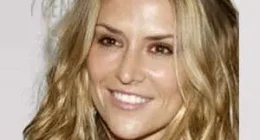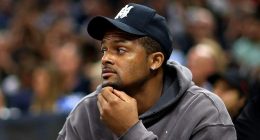With Young Love, the TV spin-off of the Oscar-winning short and beloved book, Max enters a new area of the animated family sitcom.
The concept for the show is something creator Matthew A. Cherry tells The Hollywood Reporter was knocking around as a possibility all the way back to the book’s Kickstarter days.
“When we first saw Vashti Harrison’s amazing artwork, we had always thought, ‘What could this be?’” Cherry explains. “A feature idea just felt not big enough, but what always felt like it could make a ton of sense was a series.”
Despite having a young child at the center of its narrative, the streaming show’s 12-episode first season is not for kids. Yet, it’s not quite adult animation, either. Young Love exists in a middling place rarely called upon in animation, and is one of the clearest examples of Warner Bros. Discovery and Max’s larger strategy around its animation programming.
“We wanted people who loved the book and love the short film to not be alienated by the things that felt too adult,” Cherry says. “We wanted adults, when Zuri is on camera, and we see her friend group, to hopefully still be in it, to find the comedy in this little girl who is a natural-born leader, who wants to change the world and is super outspoken.”
That’s meant putting the lead of Cherry’s expansion of the Oscar-winning short into more situations that adults can relate to. “The episode where she is selling Girl Scout Cookies — we’ve all been in a situation where somebody recruited us for work, or we got a job, and then we discover they can take advantage of us and you feel you need to figure out your own hustle,” he tells THR.
It’s not just the show’s age-defying approach to the historical children versus adult animation binary that makes the Max series signifigant in the land of animated storytelling. Thanks to its family — Angela Young (Issa Rae) and Stephen Love (Scott “Kid Cudi” Mescodi), as well as their young daughter Zuri (Brooke Monroe Conaway) — TV’s capturing the Black millenial midwestern parenting experience in rare form for animation.
THR spoke to Cherry about putting the nuances of that experience on screen in an animated form, how the show navigated its tone with some help from live-action inspirations Insecure and Fresh Prince of Bel-Air, bringing Chicago to life “in a positive light,” and working to expand the presence of Black artists and crew in the industry.
At some points, Young Love feels more like a live action family sitcom than what we typically see in animation. So what were your TV inspirations for this show?
Shows like Fresh Prince and Insecure were big references in different ways. Also Black-ish because of the multi-generational thing, and you’ve got three generations of family living in the same space. Insecure really was a good bar for the tone of the comedy. I’m not the biggest fan of broad comedy. We wanted things to feel a little drier, more situational, so Insecure was a reference for that. The Fresh Prince of Bel-Air just makes you feel good when you watch it. Shows like that back in the day, you got medicine with the candy, but also, it was just fun.
I’m so glad that you picked up that it felt like more like a live action show because that’s really how we look at it. I think the thing about Hair Love that was really cool — and gave us a lot of confidence to try to do a show in the space — is that it was really simple. It’s just a dad trying to figure out how to do his daughter’s hair, and you learn the touching reason why. Outside of the fantasy sequences, it could have been a live action thing. Trying to expand animation into a world where it could be a little bit more grounded and situational really was something that we tried to push hard for.
You’re voice cast is a lot of big names, but some who we’ve rarely or ever seen in voice acting. Did people reach out to you about being involved with Young Love’s voice cast or did you just audition everyone?
It was a mixture. Issa I’ve known since she was making Awkward Black Girl, and she was in the short. So that was the first movie that we made. She’s just so great and her voice is so distinct. We really wanted just to make sure Angela was represented well. Cudi, Scott Mescudi , is from Cleveland, the Midwest, so we love that about him. He’s young and he works in music, just like Stephen. I love the tone of his voice and the fact that he does animation.
Loretta Devine is a legend. I don’t think she’s done a lot of animation before so it was really cool getting her in the mix. I love her character design, the minilocks. Her character looks so incredible and is helping represent an older black couple in animation in a way I’ve never really seen before. It was really dope getting her and Harry Lennix, who’s actually from Chicago, so they were dope. For Brooke, who plays Zuri, we did a nationwide search. We debated should we cast an adult or should we cast a kid. Then we found Brooke in Baltimore and if you see her in real life, she’s got the big hair, a bubbly personality. She just was the best person for the job.
Tamar Braxton, Stephen’s producing partner, that character feels so similar to how she is in real life. We have a great supporting cast, too, like Debra Wilson a legendary actress, Sheryl Lee Ralph is in there, Cassandra Freeman, Sy Smith is a dope artist and she voices the teacher. It’s a great cast overall, and we really tried to with the quality of the voices. But it was a combination of them reaching out personally and let’s get their audition and see if they match up.

It’s rare to see Black millennial parents, from the Midwest no less, on screen. You have that here, with a specificity of issues, language, gender dynamics, and sense of humor. How did you decide how you wanted to portray that experience?
For us, that was a big thing. I remember like thinking, “Man, have I ever seen parents that were in their 20s in animation?” When you think about The Simpsons, Bob’s Burgers, King of the Hill, a lot of times the parents are in their 40s and 50s, already established in their career. We thought about focusing on a family that doesn’t really have a class yet. They’re not even lower or middle-class. They’re kind of pre-class, trying to figure out where they fit in the world; they have these goals and these aspirations, but they haven’t achieved them yet. They also have a young child that they’re trying to make sure that they’re present for. So a lot of the conflict is, “I gotta get to the studio and Zuri has something that she needs us to be at, so how am I going to find that balance?” That was really a big part of it.
We really tried to lean in when it came to the career side of things, too. Millennials, a lot of times, don’t just see work. It’s cool to have a job, but I’m not gonna be all about work how I saw my parents be. I will quit a job, if it’s not vibing. The freeness because of the generation that we saw that came before us. How a lot of times like, parents may not have been as present — latchkey kids — and all these different things. Friends that are young parents when we were in the middle of doing this — they’ll hit a red carpet, do their show, but also they’re going to make sure they are there at that recital, too. It’s about parenting now, where it’s not about gender roles. Rent is expensive. We both got to work. Sometimes I gotta do the hair and you gotta get to work early.
We tried to represent this world where we’re almost damn near-drowning, and we both gotta figure out how to survive. We tried to do our best to represent what we felt like a millennial parents’ situation would look like, but also having fun with it in a multigenerational way, so you can see the boomer perspective versus a Gen Z perspective.
You take on topics like generationally different approaches to faith, landlords and housing diversity, and charity in a social media age in really untypical ways for animated TV. How did you select the topics you ended up exploring in season one?
For us, it was about what are the things that we’re seeing happening in the world today. People doing charity for social media, something that we’ve seen and is happening a lot more now, can make you question people’s motives. Are they doing it because they’re genuine? But they pulled their phone out to record it and are trying to get content and bags from it. It seems a little self-motivated. We know these characters, what their flaws are and what they are into. Angela was coming off this illness and really questioning her existence in some ways. She’s trying to figure out if what she’s doing is fulfilling enough. [“Charity Love”] was one of the hardest ones because we love Angela so much, and obviously she’s doing this thing that’s on the line of taking advantage of these people. But we were trying to resolve it in really fun ways and not being afraid to cross that bar.
Obviously, housing now looks different. There are people that choose to live in their car or choose to live in a nontraditional housing situation. Someone on the outside looking in may look at it and be like, “Clearly you’re struggling,” but can find later that that was something they actually chose to do. In general, it was a matter of what are some fun topics to explore that give the same heart and experience that we got from Hair Love, but also things that we could really see a lot of conflict in the decision-making from the parents. It was putting them in scenarios that weren’t easy to resolve, where it is a complicated ending. We’re not trying to say this is the right way and this is the wrong way, but showing how a young family may be struggling and trying to navigate the world.
Were there any topics you found particularly challenging or took off the table?
We did that episode that centered around religion and Millennials that are apathetic towards that. There are definitely some things that we felt like we didn’t know if [audiences are] ready quite yet to take this on, or things that we tried to expand upon and couldn’t find an organic way to get our characters into those scenarios. But we definitely tried to push the bar a little bit. Obviously, with a first show, you’re trying to find your footing and tonally, you’re trying to make sure things feel the same episode to episode. Hopefully people dig it. The biggest thing we tried to do was just be relatable. We all can relate to being in our 20s and trying to make it. The show is set in Chicago, so it’s not like L.A. where people are having kids older. In the Midwest, you get out of college and get the family and get the house. The houses are like $100,000 or $200,000. You can live that dream in your 20s, but how do you navigate it when you’re trying to be professional and also be present for your kid.

You obviously had an art style to lean on from the books and short. But did you think about tinkering with it at all for the series?
We were able to keep a lot of things similar. Looking at the short and at Zuri’s bedroom, it’s pretty much the exact same thing with some updates. You just have a lot more world that you’re trying to explore. You’re trying to see Stephen as a producer, Angela with her hairstyling and Zuri at school. So a lot of things we did had to be made from scratch, but everything — down to the line sizing — we were trying to figure out. In some kid shows like Teen Titans Go, the bigger line spacing indicates a little bit more kiddy. Some things that are a little more adult, it’s super thin. We can barely see it. It was just trying to find a balance to represent the city; represent the characters; maintain their familiarity. They already weren’t existed in books and in the short film, but I tried to expand it in the ways that we could.
You’re from Chicago, so how accurately did you try to portray the city in this?
I’m from the northwest side of Chicago, but basically the rest of my family is from the West Side, so the house that they live in [in the show] is a remixed version of like my grandmother’s two-flat on the West Side. The different locations, the way the schools look — our art director, Ed Lee, and our supervising director Mark Davis were going onto Google Maps and traveling down different neighborhoods. If Angela works in a salon, it was probably on Madison Street. Let’s make sure that street looks similar to the different businesses on Madison. If they’re on this particular street in Chicago on the West Side, let’s see what these other two-flats are looking like around them, and what type of people are in that different neighborhood. It was a very extensive process to make sure that the styling of it felt specific to Chicago. It’s hard though because a lot of our actors aren’t from there. You want to get all the slang and super specific things in there that you can. We weren’t able to do as many as we would have liked. But I hope people really see the love and care that we put into trying to represent Chicago in a positive light because it gets such a negative light in mainstream media.
Storytelling about Black families in animation has historically not been done by crews that are predominantly Black. How did you put your crew together with so much of this being a Black-focused show?
It was really hard. When I first came to Hollywood, I did not really know who had jobs in Hollywood. I didn’t even know that was a thing, so I think we’re seeing the same thing when it comes to animation. Thankfully, with projects like Spider-Verse, The Proud Family and every new thing that comes out, more and more people get information about it. But a lot of it was just education. Our studio was Atomic Cartoons, and they’re based in Toronto, and then who did our storyboards was House of Cool. They’re based out here in [California]. We got as many Black people in the mix as we could, but there were certain things where [we couldn’t] because they simply were busy or just didn’t exist in these roles.
There was a lot of educating — we got to make sure the walk is right, we got to make sure they sit in the car in a certain way. You find yourself going a lot deeper than you normally would had they been animals or different characters like that. It was all very well worth it and we definitely put some things in place where people could train and learn along with like the crews that are actually doing it. We are really hopeful that if we do get more seasons, more people will be able to be brought in and it’s going to help diversify it even more.
Young Love releases four new episodes every Thursday through Oct. 5 on Max.
The interview was edited for length and clarity.
Also Read More: World News | Entertainment News | Celeb News
Hollywood









